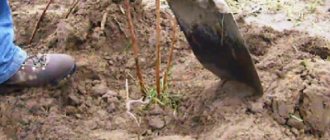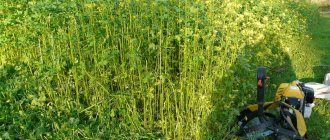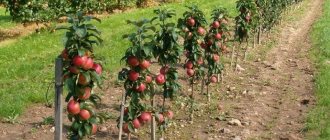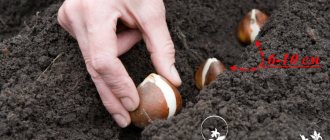Fruits and berries » Strawberries
0
782
Article rating
Kira Stoletova
At the end of the summer season, work on the site does not end. In addition to clearing the beds of carrion, weeds and vegetation debris, you should start replanting some crops. Let's consider when and how strawberries are transplanted in the fall, as well as what kind of care they require.
How to replant strawberries in the fall - basic rules
When is it better - spring or autumn?
You can plant bushes in both seasons.
Spring replanting is carried out in April, when the plant is rapidly growing its root system and shoots. You need to be in time before the strawberries bloom. If you replant during this period, the harvest will appear only next year.
But the best time to carry out the procedure is autumn. The main advantage is that plant care is reduced to a minimum. From frequent rains they will receive a sufficient amount of moisture, which will ensure rapid rooting.
As a result, you will get strong bushes that will bloom magnificently and produce the first harvest of berries. The seedlings manage to take root before the onset of cold weather and will safely survive the winter.
Regional features
In the Urals, Siberia, the Central and Northern zones, it is better to plant in the spring, so that the plants have time to take root and survive the winter safely. This period is also suitable for the Central regions, where the weather is unstable and the summer is short.
In the south, you can carry out this procedure both in spring and autumn.
You can replant garden strawberries in the first half of September: two months is enough for the seedlings to adapt and prepare for the upcoming cold weather.
If the autumn turned out to be warm, planting is allowed in October, but no later than the 15th, because the bushes may not have time to take root and will die during the first frost.
Moon calendar
Many gardeners prefer to plant strawberries in a new place, relying on the lunar calendar.
Favorable days:
- in April - 15-17, 24-26, 29, 30.
- in September - 1-5, 7-10, 17-24.
How to plant strawberries: options
Transplanting strawberries in the fall, in October, is no different from usual. Therefore, all known methods can be used:
- In one line. In this case, at least 70 centimeters must be left between the rows, and the plants should be located approximately 20 centimeters from each other.
- In two or more lines. Here the bushes are arranged in the form of classic beds, forming strip plantings. The distance between them is approximately 70 centimeters, and the lines of the bushes should be separated from each other by 30 centimeters.
Preparation
For the transplant to be successful it is necessary:
- remove from the site all specimens that have shriveled, rotted or frozen from winter frosts;
- dig up good bushes along with a lump of earth;
- dig holes at a distance of 30-40 cm according to the size of the underground part, sprinkle their bottom with sand;
- when planting, it is important that the roots are completely covered with soil, but you should not bury the bush too deeply, otherwise it will take a long time to take root and may die;
- compact the soil around the stems, loosen the top layer;
- after two weeks, complex fertilizers are applied (it is recommended to feed with preparations for berry crops).
General recommendations
A windless place is suitable for planting
To get the maximum result - good survival rate of the bushes, their rapid growth, development and abundant fruiting, you will need to follow some rules.
This is an unpretentious crop in care and maintenance, but prefers to grow on slightly acidic soil with a neutral acidity level. The soil should be light and loose.
- If you plan to grow on loam, add two buckets of sand per 1 m².
- Sandy loam soil can be improved by adding a bucket of peat. If the soil is acidified - the indicator is above 6 units, additionally sprinkle 400 g of dolomite flour, slaked lime or calcite per 1 m².
It is also important to follow the rules of crop rotation:
- Strawberries do not grow well after tomatoes, cucumbers, cabbage and potatoes.
- The best predecessors are carrots, radishes, greens, legumes and beets.
Choose a garden bed with a slight slope of 3-4°C, since in a flat place, rain will cause holes in the holes with bushes to form, moisture will accumulate in them, and as a result you will suffer large losses.
It is worth choosing an area protected from the wind. During snowy winters, plants will not freeze, and with the arrival of spring they will receive additional moisture.
Where to plant strawberries?
Pruning before planting
Strawberries grow in one place for several years, so the place for them is chosen carefully. Since strawberries are planted in the fall after the main harvest is harvested, it is possible to choose the ideal place. It should be moderately sunny, with a “walking” shadow. The bushes are not afraid of heat, but the scorching summer sun can literally incinerate the leaves and ruin the harvest. It is recommended to plant the crop after pumpkin, peas, garlic, onions or carrots.
Description of technology
The rules for transplanting are as follows: dig out small holes, approximately according to the dimensions of the root system. It is necessary to plant at a distance of 30 cm, maintaining the same distance between rows.
The bottom of the holes is sprinkled with sand, the roots are lowered so that the root collar is on the surface, covered with earth, and compacted. Then each seedling is spilled with water and mulched with peat.
You can use bushes from your own garden bed, you can also plant them using a mustache or by dividing an old plant. The planting technology is the same regardless of the type of planting material.
Young bushes
To obtain good productivity and quick survival, it is better to take two-year-old specimens. Three-year-olds are less productive, and one-year-olds are too weak and may not take root.
Young seedlings dug up in an old bed are planted immediately so that the roots do not have time to dry out. Before planting, they are inspected for damage by diseases, pests, and rot. Damaged roots are cut off with a sharp instrument, and the cut areas are sprinkled with charcoal to avoid infection of the entire bush.
Mustache
Some gardeners successfully grow annual bushes that have produced their first tendrils.
Propagation by mustaches or lateral shoots is one of the most proven and effective methods. You can get high-quality seedlings from them. The mustache absorbs the required amount of nutrients and moisture from the mother bush, then produces several leaves at a time.
Strawberries are easy to propagate by tendrils
They are separated in the place where a rosette of 4-6 sheets has formed. The strongest and most viable tendrils are the first two, which formed next to the main plant.
Before planting with a mustache, 2-3 leaves located in the center are removed from each specimen. This way the seedlings will consume less moisture and nutrients for their maintenance. The roots are pinched to 1/3 of their length, then dipped in fertilizers that stimulate the growth of the root system (Epin or Kornevin). After this, they are enveloped in a solution of water, clay and manure in a ratio of 1:1:1.
Dividing an old bush
Another method of planting strawberries in a new place is by dividing the rhizome.
This is usually recommended for planting remontant varieties that do not grow tendrils.
The advantages of this method are that the bushes retain all the varietal characteristics of the mother plant, a good opportunity to grow strong seedlings that will give a bountiful harvest next year, which cannot be achieved with the help of mustaches.
Use mature, healthy bushes with well-developed roots. The optimal age is 2-4 years. Before dividing, the root system is carefully inspected for damage by pests and diseases. All questionable areas are cut out, then the injured areas are sprinkled with wood ash.
From one plant, depending on the size of the roots, you can get from 5 to 15 young bushes. The main condition for each seedling is the presence of at least 2-3 roots and one pair of leaves.
Division can be done throughout the growing season, but the most optimal time is the end of August; by mid-September they will take root.
First, the dug bush is dipped into a container with a weak solution of potassium permanganate to destroy all pathogenic microflora, and after half an hour they begin dividing it. After drying, it should be planted in a prepared bed.
Care requirements
After transplanting strawberries to another place, it is important to provide timely and proper care, which will ensure rapid rooting and intensive growth.
Watering
Before the onset of the first autumn cold weather, the bushes are often moistened so that the roots have time to take root - once every 5 days. Provided that the autumn turned out to be dry.
The last watering is carried out 3 weeks before frost.
You can also irrigate the leaf to saturate the aboveground part with moisture. Spray once every 10 days.
Loosening and mulching
Loosening saturates the roots with oxygen
After each moistening, the soil is loosened to ensure good access of moisture, oxygen and nutrients to the root system. This is done carefully, between the rows, and not too deep, so as not to damage the surface roots.
Additionally, add mulch from peat or garden soil, which will protect against rapid drying out of the soil and prevent the growth of unnecessary vegetation in the garden bed.
In order not to resort to these procedures, many gardeners plant strawberries on agrofibre. This material has several advantages - it creates protection against drying out of soil roots, slows down the development of weeds, and prevents the appearance of pests and diseases on the root system.
Feeding
Fertilizers for bushes transplanted in autumn are not needed, because plants begin a dormant period closer to winter.
The only thing that can be done is to spray the bed leaf by leaf with a solution of potassium permanganate (50 g), ammonium molybdate (2 g) and boric acid (15 g) in a bucket of water. This fertilizing will provide strawberries with good winter hardiness.
Prevention of pests and diseases
To protect against parasites that usually live in the upper layers of the soil, it is necessary to spill the loosened soil with a solution of karbofos (3 tablespoons of substance per 10 liters of water).
Immediately after the procedure, the bushes should be covered with film or agrofibre for three hours. This will enhance the effect of the pesticide. After this time, the shelter is removed.
Additionally, it is worth carrying out preventative treatment with non-toxic home remedies. Mix vinegar, liquid soap, wood ash in one container - 2 tbsp. l. Add 3 tbsp to this mixture. l. vegetable oil. Stir, add 10 liters of water. The working solution is sprayed on the bushes and the soil underneath them.
Preparing for winter
It is important not only to learn how to replant strawberries correctly, but also to be able to preserve them until spring. Young bushes, even those that have already taken root, require insulation.
On the eve of autumn frosts, add mulch between the bushes and between the rows. Usually peat or last year's manure is used. In the Urals, Siberia, and the central zone, the optimal shelter settings are at the end of September, in the south - in the second half of October.
In severe frosts, when the winter turns out to be snowless, the bed is covered with agrofibre or film. But immediately after the low temperatures have subsided, the covering material is removed to prevent the bushes from damping off.
Is it possible to replant strawberries in October and what care does it need?
Miniature green bushes with beautiful red berries are welcome inhabitants of every garden plot.
Without red, fragrant strawberries, summer probably wouldn’t happen. In order to enjoy delicious berries every year and be able to stock up on compotes and jam for the winter, you need to take care of this rather fastidious beauty. In particular, strawberries need to be replanted regularly. This should not be done every year, but it is necessary to change her place of residence once every three years. And today we will talk about when you can replant strawberries and, of course, we will touch on the basic rules of replanting, soil preparation and other important nuances, and at the same time we will look into the question of whether it is possible to replant strawberries in October.











